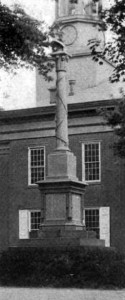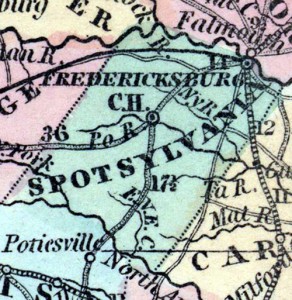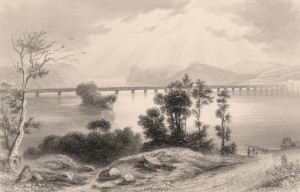 Nineteenth-century historian Robert Clemens Smedley labeled the town of Columbia, Pennsylvania as the birthplace of the organized structure that we now know as the Underground Railroad. Smedley’s posthumously published account of the Underground Railroad’s presence in Pennsylvania, History of the Underground Railroad in Chester and the Neighboring Counties of Pennsylvania (1883), is available on Dickinson College and Mercersville University’s digital collection: “Slavery & Abolition in the US: Select Publications of the 1800s .” Smedley narrates the story of the Underground Railroad with Columbia as a key station on the Underground Railroad because of its proximity to the Pennsylvania-Maryland border, just across the Susquehanna River. The Wright family, which founded Columbia in 1726, maintained a sympathetic ear towards the abolitionist cause reflecting their Quaker background. Today the Wright family home, Wright’s Ferry Mansion , is open to the public for tours. The founder’s grandson, William Wright, “an uncompromising hater of slavery,” became one of the first established agents of the Underground Railroad, setting up a network for escaping slaves in Columbia. Fergus M. Bordewich, author of the comprehensive Underground Railroad book Bound for Canaan (2005) mentions Wright briefly as “hitting on the idea of passing fugitives along from one home to another at intervals of ten or twenty miles, with other friends designated to pilot them in between.” Wright’s network included Robert Loney (or Loonee), a free black man who “ferried fugitives across the [Susquehanna] river in the night at various places below Columbia, and gave them into the care of William Wright.” Loney went on to join Company I of the 32nd Regiment of the USCT in 1864 and is buried in Columbia’s recently restored Zion Hill Cemetery (5th & Linden Streets, Columbia, PA), the burial place of many local black Civil War veterans. The Pennsylvania “Quest for Freedom ” tour, which maps the historic locations of abolition-related sites from Philadelphia to Chambersburg, includes a stop in Columbia that highlights the Zion Hill Cemetery. The USGenWeb Tombstone Transcription Project also includes a Zion Hill webpage with recent photos of fourteen USCT headstones.
Nineteenth-century historian Robert Clemens Smedley labeled the town of Columbia, Pennsylvania as the birthplace of the organized structure that we now know as the Underground Railroad. Smedley’s posthumously published account of the Underground Railroad’s presence in Pennsylvania, History of the Underground Railroad in Chester and the Neighboring Counties of Pennsylvania (1883), is available on Dickinson College and Mercersville University’s digital collection: “Slavery & Abolition in the US: Select Publications of the 1800s .” Smedley narrates the story of the Underground Railroad with Columbia as a key station on the Underground Railroad because of its proximity to the Pennsylvania-Maryland border, just across the Susquehanna River. The Wright family, which founded Columbia in 1726, maintained a sympathetic ear towards the abolitionist cause reflecting their Quaker background. Today the Wright family home, Wright’s Ferry Mansion , is open to the public for tours. The founder’s grandson, William Wright, “an uncompromising hater of slavery,” became one of the first established agents of the Underground Railroad, setting up a network for escaping slaves in Columbia. Fergus M. Bordewich, author of the comprehensive Underground Railroad book Bound for Canaan (2005) mentions Wright briefly as “hitting on the idea of passing fugitives along from one home to another at intervals of ten or twenty miles, with other friends designated to pilot them in between.” Wright’s network included Robert Loney (or Loonee), a free black man who “ferried fugitives across the [Susquehanna] river in the night at various places below Columbia, and gave them into the care of William Wright.” Loney went on to join Company I of the 32nd Regiment of the USCT in 1864 and is buried in Columbia’s recently restored Zion Hill Cemetery (5th & Linden Streets, Columbia, PA), the burial place of many local black Civil War veterans. The Pennsylvania “Quest for Freedom ” tour, which maps the historic locations of abolition-related sites from Philadelphia to Chambersburg, includes a stop in Columbia that highlights the Zion Hill Cemetery. The USGenWeb Tombstone Transcription Project also includes a Zion Hill webpage with recent photos of fourteen USCT headstones.
28
Jun
10
The Underground Railroad in Columbia, Pennsylvania
Posted by solnitr Published in 19th Century (1840-1880), Images, Places to Visit, Rare Books Themes: Battles & Soldiers, Slavery & Abolition25
Jun
10
Dickinson College President Jesse Peck – “A Practical Joke”
Posted by sailerd Published in Antebellum (1840-1861), Historic Periodicals Themes: Carlisle & Dickinson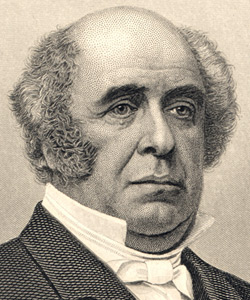 When Dickinson College President Jesse Peck arrived in Staunton, Virginia, for a conference in the spring of 1849, local authorities detained him as a result of a prank by Dickinson students. As the Richmond (VA) Examiner reported:
When Dickinson College President Jesse Peck arrived in Staunton, Virginia, for a conference in the spring of 1849, local authorities detained him as a result of a prank by Dickinson students. As the Richmond (VA) Examiner reported:
“some reprobate student…wrote a letter to the Physician of the Hospital [in Staunton], giving him a description of some individual who had left Carlisle, the seat of Dickinson College, in a state of mental derangement; and stating, furthermore, that it was more than probable that the said individual had betaken himself to Staunton, inasmuch as it was a sort of monomania with him to regard himself as the President of [Dickinson College],…. It is needles to add, that the description of the insane person coincided precisely with the appearance of the Rev. Doctor himself – and that it required the reiterated identifications of the ministers of the Conference around, to save him from confinement!”
Moncure Conway (Dickinson College Class of 1849), who later became a southern abolitionist, admitted that he was one of the student leaders involved with the prank. You can read the full story here.
24
Jun
10
 A new political movement born out of New York and Philadelphia spread across the country, emerging in Cumberland County in 1854, shaping its politics for more than two years. Spurred by anti-Catholic and anti-immigration sentiment, the Know Nothing party grew to significant prominence if only for a short period during the mid 1850s. Reverend Otis H. Tiffany was Dickinson College’s professor of mathematics and president of the Know Nothing State Council. Tiffany, a prominent leader and adamant speaker for the Know Nothing party, gave a public lecture at Carlisle Union Fire Hall on November 16, 1854 on the Protestant origins of American freedoms and on the dangers of the vast immigration and rapid naturalization of foreigners. Tiffany commented, “No foreigner is competent to discharge the duties of an American until he ceases to be identified with the land which gave him birth.”
A new political movement born out of New York and Philadelphia spread across the country, emerging in Cumberland County in 1854, shaping its politics for more than two years. Spurred by anti-Catholic and anti-immigration sentiment, the Know Nothing party grew to significant prominence if only for a short period during the mid 1850s. Reverend Otis H. Tiffany was Dickinson College’s professor of mathematics and president of the Know Nothing State Council. Tiffany, a prominent leader and adamant speaker for the Know Nothing party, gave a public lecture at Carlisle Union Fire Hall on November 16, 1854 on the Protestant origins of American freedoms and on the dangers of the vast immigration and rapid naturalization of foreigners. Tiffany commented, “No foreigner is competent to discharge the duties of an American until he ceases to be identified with the land which gave him birth.”
Many of the sources on the Know Nothings in Cumberland County are derived from local newspapers such as the Carlisle American, Carlisle Herald, Shippensburg News and American Volunteer. During this time, Tiffany and several other professors at Dickinson College had been active in the Know-Nothing movement. While most of the papers were supportive, the American Volunteer was the most negative, commonly criticizing the party and the involvement of Tiffany and others from Dickinson College. On August 23, 1857 with the Know Nothing movement nearly dissolved, the Volunteer cited the negative effects brought on by the faculty “by their constant dabbling in politics…But we gained our point which was to drive them from their Know-Nothing lodges to their duties in the College.”
While unsuccessful in sustaining the Know Nothing movement in Cumberland County, Tiffany was and remained a respected leader throughout the community. In Alexander Kelly McClure‘s Old Time Notes of Pennsylvania, he comments on the merits of Tiffany. McClure, a prominent Pennsylvania politician and journalist, regarded Tiffany as the ablest of all the Know-Nothing leaders.
“The one who stood out most conspicuous as an active politician and consistent Christian gentleman was Dr. Tiffany, who, as I have stated, accomplished the union of the opposition forces at the conference in 1855. He was not only a man of unusual eloquence, but a sagacious leader in Church and State, and always commanded the respect of all who came in contact with him, whether supporting or opposing him.”
24
Jun
10
The Soldiers Monument
Posted by mckelveb Published in Places to Visit, Reconstruction (1865-1880) Themes: Battles & Soldiers, Carlisle & DickinsonThe Soldiers Monument in Carlisle, Pennsylvania was created in a post war effort to honor the Cumberland County soldiers who died as a result of the Civil War. The efforts to build the monument were initiated by the Soldiers Monument Association in early January 1867, which included General Lemuel Todd as Chair, General Robert Miller Henderson as President, and Colonel Erkuries Beatty as Corresponding Secretary. The minutes of the Soldiers Monument Association are available for reference at the Cumberland County Historical Society in Carlisle, Pennsylvania. Fundraising continued into early 1871 until the Monument Association obtained the five thousand dollars needed to erect the monument. The extra money financed the dedication ceremonies as well as the fence that enclosed the monument. A Carlisle mechanic, Richard Owens, was responsible for contracting and designing the monument, which contained a “Roll of Honor” that provided the names of the three hundred and forty-four Cumberland County officers and soldiers that died in combat or during their term of service in the army during the Civil War. The official unveiling of the thirty foot tall Soldiers Monument took place on the Public Square near the Carlisle Courthouse on August 19, 1871 with Lemuel Todd as Chief Marshall of the ceremonies and Major General Heintzelman as the presenter of the unveiled monument. Available on Google Books, Carlisle, Old and New gives a brief description of the monument as well as some of the other historical features in Carlisle.
23
Jun
10
The Battle of Fort Henry: February 6, 1862
Posted by rainwatj Published in Civil War (1861-1865), Images, Maps Themes: Battles & Soldiers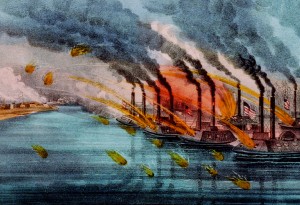 On February 6, 1862, Union Brigadier General Ulysses S. Grant and Union Flag Officer Andrew Hull Foote scored the first major victory for the Union Army in the Western Theater in the battle of Fort Henry along the Tennessee River near Stewart County and Henry County, Tennessee and Calloway County, Kentucky. Inundated by recent rain and flood water, the poorly conceived and outdated fort was defended by Confederate Brigadier General Lloyd Tilghman and just over 3000 Confederate soldiers. Grant and his 15,000 Union troops surrounded the fort while Foote and his seven gunboats began bombarding the fort. Foote and the Union’s naval power proved decisive as Tilghman surrendered before Grant’s soldiers even reached the fort. Estimated casualties for the battle were low with only 40 for the Union Army and just 80 for the Confederates. The victory at Fort Henry gave the Union Army access to the Tennessee River, a major water highway into the heart of the Confederate Deep South. In Ulysses S. Grant’s Civil War memoirs, he comments on the strategic importance of the capture of Fort Henry:
On February 6, 1862, Union Brigadier General Ulysses S. Grant and Union Flag Officer Andrew Hull Foote scored the first major victory for the Union Army in the Western Theater in the battle of Fort Henry along the Tennessee River near Stewart County and Henry County, Tennessee and Calloway County, Kentucky. Inundated by recent rain and flood water, the poorly conceived and outdated fort was defended by Confederate Brigadier General Lloyd Tilghman and just over 3000 Confederate soldiers. Grant and his 15,000 Union troops surrounded the fort while Foote and his seven gunboats began bombarding the fort. Foote and the Union’s naval power proved decisive as Tilghman surrendered before Grant’s soldiers even reached the fort. Estimated casualties for the battle were low with only 40 for the Union Army and just 80 for the Confederates. The victory at Fort Henry gave the Union Army access to the Tennessee River, a major water highway into the heart of the Confederate Deep South. In Ulysses S. Grant’s Civil War memoirs, he comments on the strategic importance of the capture of Fort Henry:
“With Fort Henry in our hands we had a navigable stream open to us up to Muscle Shoals, in Alabama. The Memphis and Charleston Railroad strikes the Tennessee at Eastport, Mississippi, and follows close to the banks of the river up to the shoals. This road, of vast importance to the enemy, would cease to be of use to them for through traffic the moment Fort Henry became ours.”
From Fort Henry to Corinth by Manning Ferguson Force is an available online nineteenth century resource for a narrative on the battle utilizing several maps to emphasize the importance of the strategic impact of capturing the fort is fully available on Google Books. Where the South Lost the War: An Analysis of the Fort Henry-Fort Donelson Campaign, February 1862 by Kendall D. Gott is another valuable book on the battle that can be previewed on Google Books. The Tennessee Encyclopedia of History and Culture provides an informative overview of the battle and has suggested readings for more information on the battle. The Library of Congress has a number of images and maps of the fort and surrounding areas.
23
Jun
10
William P. Willey’s April 1861 letters
Posted by solnitr Published in Civil War (1861-1865), Letters & Diaries Themes: Carlisle & Dickinson William Patrick Willey, Dickinson College Class of 1862, was determined to graduate even though all odds seemed to be against him. As a junior in college, Willey’s world erupted as his country went to war with itself after the battle of Fort Sumter on April 12, 1861. Ten days later Willey wrote his father, the future West Virginia senator Waitman T. Willey, of the precarious situation he was in as a Southern student in Carlisle, Pennsylvania. William sent two letters to his father within a one week period: one on April 22 and the second on April 29. Within this week William perceived that the situation in Carlisle had changed dramatically. In his first letter, William described the excited mobs of townspeople at the train station: “women bidding adieu to their husbands and sons.” Though a committee from the town approached the college’s president, Dr. Herman Merills Johnson, informing him that Southern students must either leave or take an oath of allegiance, William told his father that he would try to stay as long as he could: “I fear nothing yet. The only ones that are in danger are the students from S.C.” One week later, William and his friend McCants were the only Southern students left. Now however, Carlisle residents complimented William on his dedication for remaining at school. More often, William wrote, he and McCants were approached for their opinion as Southerners because “in Carlisle the prominent desire seems to be that of getting a hold on Jeff Davis.” William’s two letters document the remarkable shift in emotions of Carlisle residents after the immediate shock of Fort Sumter wore off—by April 29th it appeared that the women of Carlisle no longer felt it necessary to arm themselves with broomsticks against a possible Southern attack. After graduating, William P. Willey went on to earn his law degree and became a law professor at West Virginia University, where he founded the West Virginia Law Review in 1894.
William Patrick Willey, Dickinson College Class of 1862, was determined to graduate even though all odds seemed to be against him. As a junior in college, Willey’s world erupted as his country went to war with itself after the battle of Fort Sumter on April 12, 1861. Ten days later Willey wrote his father, the future West Virginia senator Waitman T. Willey, of the precarious situation he was in as a Southern student in Carlisle, Pennsylvania. William sent two letters to his father within a one week period: one on April 22 and the second on April 29. Within this week William perceived that the situation in Carlisle had changed dramatically. In his first letter, William described the excited mobs of townspeople at the train station: “women bidding adieu to their husbands and sons.” Though a committee from the town approached the college’s president, Dr. Herman Merills Johnson, informing him that Southern students must either leave or take an oath of allegiance, William told his father that he would try to stay as long as he could: “I fear nothing yet. The only ones that are in danger are the students from S.C.” One week later, William and his friend McCants were the only Southern students left. Now however, Carlisle residents complimented William on his dedication for remaining at school. More often, William wrote, he and McCants were approached for their opinion as Southerners because “in Carlisle the prominent desire seems to be that of getting a hold on Jeff Davis.” William’s two letters document the remarkable shift in emotions of Carlisle residents after the immediate shock of Fort Sumter wore off—by April 29th it appeared that the women of Carlisle no longer felt it necessary to arm themselves with broomsticks against a possible Southern attack. After graduating, William P. Willey went on to earn his law degree and became a law professor at West Virginia University, where he founded the West Virginia Law Review in 1894.
23
Jun
10
Carlisle Fencibles
Posted by mckelveb Published in Civil War (1861-1865), Letters & Diaries, Rare Books Themes: Battles & Soldiers, Carlisle & Dickinson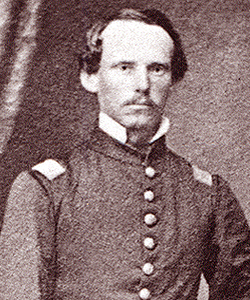 After the outbreak of the Civil War, four volunteer companies originally consisting of fifty to one hundred men were recruited in Carlisle, Pennsylvania on April 19, 1861. On April 21, the officers were chosen with Captain Robert M. Henderson, in charge of Company A of the 36th Regiment, 7th Pennsylvania Reserve Corps. Henderson was assisted in command by First Lieutenant James S. Colwell, Second Lieutenant Erkuries Beatty, and First Sergeant John D. Adair. These men received the nickname “Carlisle Fencibles” in part because most of its members belonged to a gymnastic club and because a “fencible” is a defender of a country. The company spent a two month period of relative inactivity marching and drilling until the soldiers left for Camp Wayne in West Chester, Pennsylvania on June 6. Before the men departed they received a satin flag from Mrs. Samuel Alexander, a granddaughter of Ephraim Blaine, that, according to David G. Colwell, had the inscription “May God defend the right!” The 7th Pennsylvania Reserves went on to fight in the Battles of Gaines’ Mill, Bull Run, and Antietam while suffering great losses. A more thorough description of the experiences of the company is available on Google Books in Samuel B. Bates’ History of Pennsylvania Volunteers, 1861-65 . The wartime experience of one member of the Carlisle Fencibles, John Taylor Cuddy, is chronicled through letters he sent home to his family in Carlisle. His correspondence is available as a part of Dickinson College’s “Their Own Words” digital archive which provides a picture of the experience of a young Carlisle Fencible during the Civil War.
After the outbreak of the Civil War, four volunteer companies originally consisting of fifty to one hundred men were recruited in Carlisle, Pennsylvania on April 19, 1861. On April 21, the officers were chosen with Captain Robert M. Henderson, in charge of Company A of the 36th Regiment, 7th Pennsylvania Reserve Corps. Henderson was assisted in command by First Lieutenant James S. Colwell, Second Lieutenant Erkuries Beatty, and First Sergeant John D. Adair. These men received the nickname “Carlisle Fencibles” in part because most of its members belonged to a gymnastic club and because a “fencible” is a defender of a country. The company spent a two month period of relative inactivity marching and drilling until the soldiers left for Camp Wayne in West Chester, Pennsylvania on June 6. Before the men departed they received a satin flag from Mrs. Samuel Alexander, a granddaughter of Ephraim Blaine, that, according to David G. Colwell, had the inscription “May God defend the right!” The 7th Pennsylvania Reserves went on to fight in the Battles of Gaines’ Mill, Bull Run, and Antietam while suffering great losses. A more thorough description of the experiences of the company is available on Google Books in Samuel B. Bates’ History of Pennsylvania Volunteers, 1861-65 . The wartime experience of one member of the Carlisle Fencibles, John Taylor Cuddy, is chronicled through letters he sent home to his family in Carlisle. His correspondence is available as a part of Dickinson College’s “Their Own Words” digital archive which provides a picture of the experience of a young Carlisle Fencible during the Civil War.
22
Jun
10
Outbreak of War at Dickinson College
Posted by rainwatj Published in Civil War (1861-1865), Letters & Diaries Themes: Carlisle & Dickinson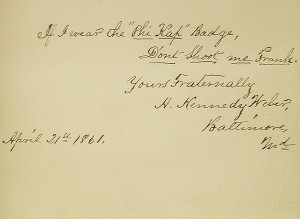 The Dickinson College student body was evenly divided between Northern and Southern students who fought on both sides of the conflict. The split is well documented in Dickinson College class of 1861 student Francis Benjamin Sellers’ Autograph Album for the Phi Kappa Sigma Fraternity. Taken from the Phi Kappa Sigma News Letter, Fall, 1954:
The Dickinson College student body was evenly divided between Northern and Southern students who fought on both sides of the conflict. The split is well documented in Dickinson College class of 1861 student Francis Benjamin Sellers’ Autograph Album for the Phi Kappa Sigma Fraternity. Taken from the Phi Kappa Sigma News Letter, Fall, 1954:
“On April 21, 1861, Epsilon held its last meeting shortly past midnight. All of the members gathered in the room of John. E McCahan and Francis B. Sellers in West College and dispensed with the usual forms of business so that the brothers could say their last farewells before leaving for their respective armies.”
Dickinson College students expected to encounter one another on the battlefield, which is reflected in the comments left in the autograph album. Howard Kennedy Weber class of 1863 remarked: “If I wear the “Phi Kap” badge, don’t shoot me Frank.”
Other Dickinson College students featured in Sellers’ album that fought in the conflict include fellow classmates Elbridge Hoffman Gerry, James Glasgow Archer, William Miller Ogilby and Ernest Dudley Martin.
22
Jun
10
The Battle of the Wilderness, May 5-7, 1864
Posted by mckelveb Published in Civil War (1861-1865), Images, Lesson Plans, Maps, Places to Visit Themes: Battles & SoldiersThe Battle of the Wilderness (also known as Combats at Parker’s Store, Craig’s Meeting House, Todd’s Tavern, Brock Road, and the Furnaces) took place from May 5-7, 1864 in Spotsylvania County, Virginia as a part of Union General Ulysses S. Grant ’s overland campaign. Grant’s troops attacked General Robert E. Lee and the Army of Northern Virginia on May 5 and a fierce fight broke out between the soldiers. There were high casualties on both sides, including Union General James Wadsworth and Confederate General John M. Jones. The National Park Service’s website provides a detailed overview of the fighting and profiles on various historical figures that fought in the battle. Teachers may find the suggested reading list and the information for visiting the battlefield posted on the website useful for planning a fieldtrip to the area. The National Park Service also includes a virtual tour of the battleground for those that cannot make the trip as well as photos of the different sites and monuments. The Civil War Preservation Trust’s website has some interesting historical maps which may be valuable to take a look at. A study of the Battle of the Wilderness may be useful to incorporate into lessons on African American troops in the Civil War since the 43rd USCT served in the Wilderness Campaign along with other United States Colored Troop regiments. A previous post outlines the actions of the 43rd USCT during the Wilderness campaign. Gordon C. Rhea commented on the outcome of the battle in his book:
“The recent carnage could be viewed as the opening salvo of a protracted battle to end the war in Virginia. Grant’s directive represented the maturation of his thinking. Lee, Grant was conceding, could not be beaten here. But the campaign was not over. Grant would fight again, next time on the fields that offered him the upper hand. Lincoln’s new commander in chief had been checked, but not defeated. “
22
Jun
10
The John Taylor Cuddy Correspondence
Posted by solnitr Published in Civil War (1861-1865), Letters & Diaries Themes: Battles & Soldiers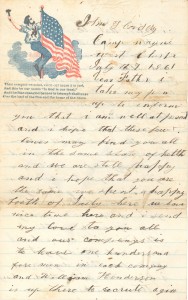 Sixteen-year-old John Taylor Cuddy left his home in Carlisle, Pennsylvania to enlist in Company A of the 36th Pennsylvania Infantry on June 5, 1861. Over the next two years, Cuddy wrote 77 letters home to his family describing his experiences as a soldier in the Union army. Cuddy’s correspondence is available online as part of Dickinson College’s “Their Own Words” digital archive. Over the course of his service in the army, Cuddy wrote his parents full of exuberance to go “lick the south” from his training camp at Fort Wayne, with a tempered tone of experience after fighting in the battle of Gaines’ Mill, and with a critical analysis of “old abe[‘s]” Emancipation Proclamation. At the Battle of the Wilderness, which lasted from May 5 to 7, 1864, Cuddy’s regiment was captured and sent to Andersonville, a Confederate prisoner of war camp in Georgia. With his capture, Cuddy’s letters stopped. Although John Taylor Cuddy never made it home to Pennsylvania (he died in a prison in Florence, South Carolina on September 29, 1864), his correspondence creates a living picture of the life of a teenage Pennsylvania soldier during the Civil War.
Sixteen-year-old John Taylor Cuddy left his home in Carlisle, Pennsylvania to enlist in Company A of the 36th Pennsylvania Infantry on June 5, 1861. Over the next two years, Cuddy wrote 77 letters home to his family describing his experiences as a soldier in the Union army. Cuddy’s correspondence is available online as part of Dickinson College’s “Their Own Words” digital archive. Over the course of his service in the army, Cuddy wrote his parents full of exuberance to go “lick the south” from his training camp at Fort Wayne, with a tempered tone of experience after fighting in the battle of Gaines’ Mill, and with a critical analysis of “old abe[‘s]” Emancipation Proclamation. At the Battle of the Wilderness, which lasted from May 5 to 7, 1864, Cuddy’s regiment was captured and sent to Andersonville, a Confederate prisoner of war camp in Georgia. With his capture, Cuddy’s letters stopped. Although John Taylor Cuddy never made it home to Pennsylvania (he died in a prison in Florence, South Carolina on September 29, 1864), his correspondence creates a living picture of the life of a teenage Pennsylvania soldier during the Civil War.
